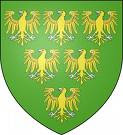Despencer, of course, held vast lands in Wales, including the impressive Caerphilly Castle, where Edward and Despencer sought refuge when Edward's Queen, Isabella, landed with an army to depose Edward. Caerphilly Castle was a mighty fortress, and should easily have been able to hold out if under siege. For reasons unknown, Edward and Hugh left Caerphilly for Neath Abbey. It seems a foolhardy thing to do - leave a well-fortified castle for a religious house - but maybe Edward hoped the Abbey would provide him with sanctuary? He sent the abbot to try to negotiate with Isabella, but when no compromise could be reached, Edward and Hugh set out to return to Caerphilly Castle. It was on their return that Edward and Hugh were captured. For many years afterwards, stories about Edward's possessions being 'stolen' or found around Neath Abbey have persisted. There are stories of gold coins being found after being hidden in various nooks and crannies in the Abbey. Rumour has it Edward had £30,000 with him. And yet, visitors to Neath Abbey have no idea of this part of the Abbey's history, for no-where on the information boards is it mentioned. How can such an important part of history be ignored? Below are some of the pictures I took.
Above - the Tudor Manor House. Below are the ruins of the Abbey.







